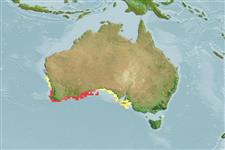>
Ophidiiformes (Cusk eels) >
Dinematichthyidae (Viviparous brotula)
Etymology: Dermatopsoides: Greek, derma = skin + Greek, opsis = appearance (Ref. 45335); morrisonae: Named for Sue M. Morrison, Perth, WAM..
More on authors: Møller & Schwarzhans.
Environment: milieu / climate zone / depth range / distribution range
Ecologia
marinhas demersal; intervalo de profundidade 5 - 10 m (Ref. 57886). Tropical
Eastern Indian Ocean: Western Australia.
Tamanho / Peso / Idade
Maturity: Lm ? range ? - ? cm
Max length : 2.9 cm SL (female)
Descrição suscinta
Chaves de identificação | Morfologia | Morfometria
Raios dorsais (total) : 72 - 76; Raios anais : 52 - 54; Vértebras: 42 - 44. The species is characterized by the following: vertebrae 13-14 + 28-31 = 42-44, dorsal fin rays 72-76, anal fin rays 52-54; scales present on body; dorsal and anal fins dark; snout terminal; lower lip with skin folds; ventral fin length 15.8-18.5 % SL; posterior nostril moderately small, more than half the size of eye; lower preopercular pores 3, small; weak ventral spine on
maxilla positioned behind rear of eye (Ref. 57886).
Ciclo de vida ou comportamento de acasalamento
Maturities | Reprodução | Spawnings | Egg(s) | Fecundities | Larvas
Møller, P.R. and W. Schwarzhans, 2006. Review of the Dinematichthyini (Teleostei, Bythitidae) of the Indo-west Pacific, Part II. Dermatopsis, Dermatopsoides and Dipulus with description of six new species. The Beagle 22:39-76. (Ref. 57886)
Status na Lista Vermelha da UICN (Ref. 130435)
Ameaça para os humanos
Harmless
Uso pelos humanos
Ferramentas
Relatórios especiais
Baixar XML
Fontes da internet
Estimates based on models
Preferred temperature (Ref.
123201): 17.4 - 18.4, mean 18.1 °C (based on 44 cells).
Índice de diversidade filogenética (Ref.
82804): PD
50 = 0.5625 [Uniqueness, from 0.5 = low to 2.0 = high].
Bayesian length-weight: a=0.00389 (0.00180 - 0.00842), b=3.12 (2.94 - 3.30), in cm total length, based on all LWR estimates for this body shape (Ref.
93245).
Nível Trófico (Ref.
69278): 3.1 ±0.5 se; based on size and trophs of closest relatives
Fishing Vulnerability (Ref.
59153): Low vulnerability (10 of 100).
